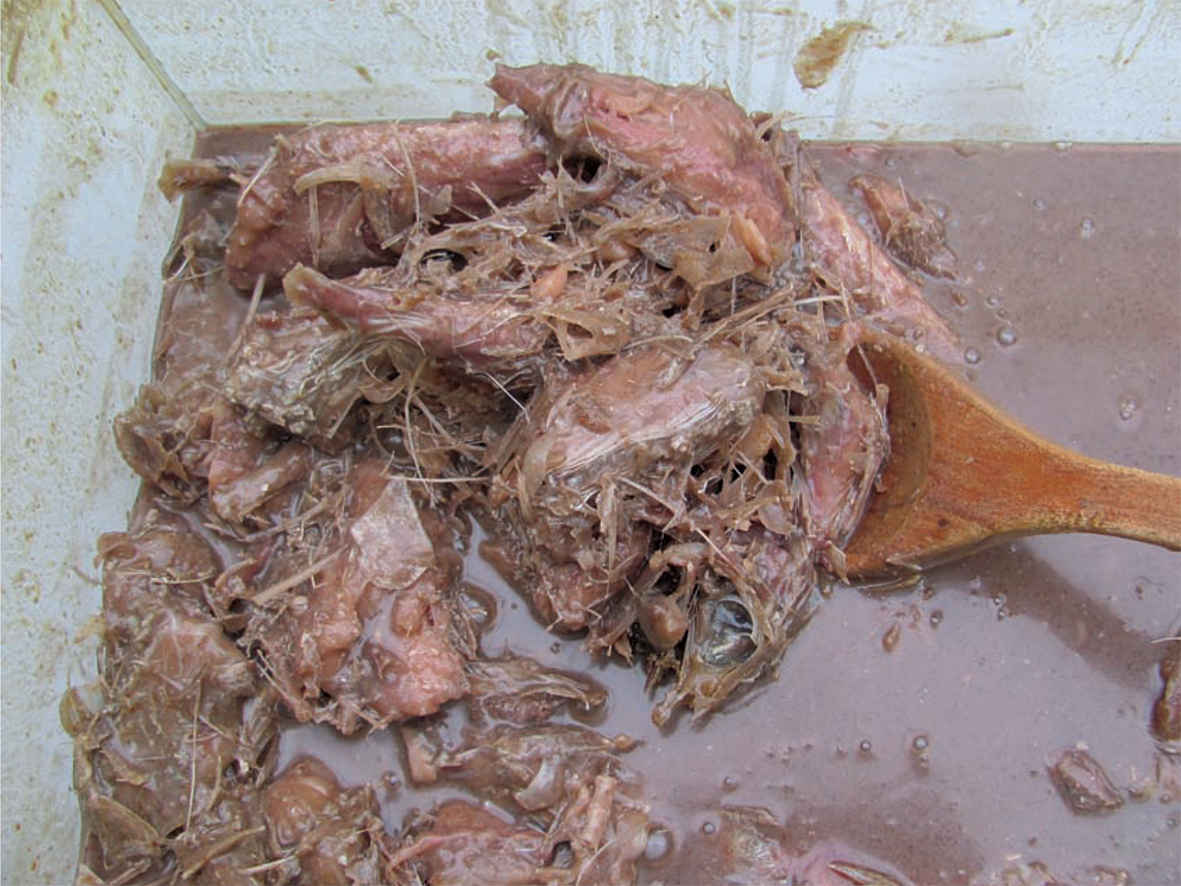Roman Fish Sauce: Fish Bones Residues and the Practicalities of Supply
SALLY GRAINGER
Timberua Glen road. Grayshott Hindhead. Surrey GU266NB, UK sallygrain@aol.com
(Received 2 November 2012; Revised 14 May 2013; Accepted 22 May 2013)
ABSTRACT: In this paper I will report on the results of experiments, conducted from 2009 through to 2011, to manufacture Roman fish sauce, using the ancient recipes. More specifical- ly, it will consider the nature of the fish sauce residue, known as allec, observe its formation and assess its qualities. The paper concludes that many shipwrecks currently identified as having transported amphorae that contained a salted fish product made from mackerel may in fact be shipping a semi processed fish sauce which will go on to produce a quality liquamen type sauce at its destination. This paper offers a new interpretation of the archaeological remains found in ancient transport amphorae and provides new insights into the commerce of processed fish products in the Roman Mediterranean.
RESUMEN: En este trabajo se exponen los resultados de experimentos realizados entre 2009 y 2011 para manufacturar salsas de pescado romano siguiendo las recetas antiguas. En concreto, se considerará la naturaleza del residuo de salsa de pescado conocido como allec, y se detalla- rán su génesis y sus características. El trabajo concluye que muchos pecios, actualmente rese- ñados como portadores de ánforas que contenían una salazón de caballas, podrían de hecho haber contenido una salsa de pescado a medio procesar que habría servido de base para produ- cir una salsa de calidad tipo liquamen en destino. Este trabajo ofrece por tanto una nueva inter- pretación de los restos arqueológicos de peces recuperados en antiguas ánforas de transporte al tiempo que proporciona nuevas perspectivas en torno al comercio de productos procesados de pescado en el Mediterráneo romano.
INTRODUCTION
In this paper I report on the results of experiments, conducted from 2009 through to 2011, to manufacture Roman fish sauce, using the ancient recipes. More specifically this study examines the nature of the fish sauce residue, known as allec, observes its formation and assesses its qualities. Currently, our ability to recognize evidence of fish sauce through its residues in the archaeological record is limited by a lack of basic empirical knowledge of the products themselves. Van Neer & Ervynck (2002: 208) consider that fish sauce can only be identified where «fish bones are present» which is clearly a limiting factor for fishbone specialists interested in finding fish sauce in the archaeological record. The fish sauce associated with these residues of bone is perceived to be of lower status, while the fish sauce of quality is understood to be a clear free-flowing liquid and therefore largely invisible in the archaeological record (Desse-Berset & Desse, 2000: 75). In archaeology, we also continue to consider garum as a luxury fish sauce, and refer to classical archaeologists such as Curtis who necessarily use ancient «elite» perspectives from Rome to define the sauces (Corcoran, 1962; Curtis, 1991, 2009). The archaeological evidence for fish sauce, however, provides the sub-elite and even lower status perspective as the residues we find are largely identified as either the bulk commonplace sauce or the bony fish paste which is considered a slave ration. It has been difficult to reconcile and inte- grate the two worlds, the elite perspectives derived from literature and the lower status perspective from the archaeological record, to form a coherent picture of the ancient trade in fish sauce (Van Neer & Ervynck, 2002: 208). This paper offers a close study of the preparation of various fish sauces along with their residues in order to offer a new interpretation of the archaeological remains found in ancient transport amphorae and to understand more clearly Roman commerce of processed fish products1.
My approach has been multi disciplinary exam- ining and analyzing information from a variety of sources: the archaeological record for processing sites, the amphorae trade and the fish bone studies from ship wrecks and urban deposits, as well as ancient and modern literature pertaining to fish sauce production and use. My backgrounds are ideally suited to this study as I am a trained chef, have an ancient history degree, a published Roman food historian with a specialty in the Apicius recipe text where fish sauce is a commonplace ingredient, and I am trained in archaeology, having earned a MA in this discipline (Dalby & Grainger, 1996; Grainger, 2006; Grocock & Grainger, 2006). Thus I was able to integrate all the available evidence for fish sauce, both ancient and modern, in order to attempt to answer some of the more perplexing questions about this product and how it was traded.
1 My research forms part of a MA dissertation on fish sauce conducted at Reading University.
FISH SAUCE: THE BASICS
Both ancient and modern fish sauce is a liquid derived from the maceration and liquefaction of whole fish with salt. The process is known as enzyme hydrolysis. The enzymes are present in the viscera in large quantities, particularly the liver and spleen, and it is their action that converts the solid protein in the muscle tissue into amino acids and peptides dissolvable in the water (Mciver et al., 1982: 1017; Curtis, 2009: 712). The «sauce» is effectively the water contained within the fish, enriched with protein, as well as additional brine which takes on the same characteristics. The protein causes the fluid to be stained in various shades of yellow to brown. The sauces are often considered fermented, but, strictly speaking, fermentation requires bacterial action in relatively low salt conditions which are not mentioned in the ancient recipes (Owens & Mendoza, 1985: 273). There are various methods employed by modern South East Asian manufacturers which we find mirrored in the ancient recipes. The small Clupeidae and Sparidae commonly used are either, on a small scale, contained in sealed vessels, or, on a large scale, covered in concrete-lined tanks, which expose the product to the heat of the sun and some evaporation. Sometimes the fish are compressed in sealed barrels, which allow the fluid to drain from the bottom of the vessel while the residue remains intact. This compressed residue is then re-brined, often many times to extract all the potential nutrients before the residue is finally discarded or used for fertilizer, in contrast to ancient fish sauce residues which are used as another food source. Modern fish sauce is also produced in levels of salt considered excessive, 25-40% by weight. These levels of salt, which are acceptable in South East Asia, actually reduce enzyme activity and there- fore the potential nutritional value of the sauces (Crisan & Sands, 1975: 106; Lopetcharat, 2001: 65-68).
Ancient recipes for fish sauce survive in late Imperial Greek and Latin texts, though they are considered problematic for many reasons. The key text, the manuscript of the Geoponica is from Greek-speaking Byzantium and has been consid- ered too far removed in time from the manufacture of fish sauce envisioned in the western Mediterranean of the 1st century AD to be considered accurate (Comis & Re, 2009: 35). It is rarely suffi- ciently acknowledged, however, that fish sauces were Greek in origin in terms of the textual evidence, and their origins geographically were obscure 2. The cuisine we think of as Roman was originally devised and initially recorded in Greek texts during the 3rd and 2nd centuries BC. It subsequently spread and became an international Mediterranean cuisine rather than simply «Roman». Nevertheless, there remained key differences between the two culinary cultures, while, at the same time, a complex linguistic culinary crossover developed3. In fact, it is recognized in classical studies that the knowledge associated with all practical preparations was predominantly of Greek origin and found in veterinary, medicinal and culinary literature. The Romans in the western Mediterranean did not value practical skills and considered the labour associated with preparing fish sauce as demeaning, and, therefore, frequent- ly relied on the skills of Greek practitioners (Cicero de off. 1.150; Adams, 1995: 1-209; Dalby, 1996: 179; Grant, 2000: 3). The Geoponica was a farming manual preserved in a 10th century AD manuscript but containing material dated to the 6th century AD. It has recently been re-evaluated and correctly recognized as a manual preserving knowledge from the agricultural tradition of the entire Roman period rather than from the later periods and as such would, in fact, provide a reli- able account of fish sauce manufacture (Dalby, 2011: 13).
2 The process itself has either been attributed to Greeks via colonies in the Black Sea or a Phoenico-Punic one in Spain (Trakadas, 2004: 47).
3 The language of the kitchen was Greek in the same way as French dominated the professional kitchen of 19th/20th century. Cooking as a skill was dominated by Greek speaking/under- standing Romans who might be bilingual in the kitchen but not elsewhere and many terms were simply transliterated and a «culinary syntheses» emerged (Dalby,1996: 179).
There are three recipes that survive in the literature: two in the Geoponica, and one attributed to Gargilius Martialis, a 3rd century AD Latin writer. This text, however, is considered a medieval gloss and is not included in the recent Les belle Lettres series. It is also clear that a number of ingredients listed in the recipe were unavailable in Roman times, and, as a result, it is far less reliable in illustrating classical Roman practices (Curtis, 1984: 148; Maire, 2002). The texts are sited in full in the appendix. The recipes suggest that two basic types of sauce existed, though many different species of fish and different methods were used.
1 A mixture of small whole fish of the Clupeidae and Sparidae families considered small enough with the addition of extra viscera from other fish and salt added, allowing the mixture to liquefy in the sun until pickled. Liquid is then taken when the sauce flows through a basket and can be ladled out (Geo- ponica). This is a liquamen in Latin and garon in Greek4.
2 A mixture of somewhat larger fish, dominated by Scombridae as well as Clupeidae and Sparidae. These are cut up with salt and also the residue from previous fish sauce production known as allec 5 added. Apparently, no additional viscera was needed. Extra liquid (wine) could be used. This is pickled for 2-3 months (Geoponica). This is also liquamen in Latin and garon in Greek.
3 A similar variety of fish but the whole process is made in a sealed vessel and on a smaller scale (Gargilius Martialis). This is liquamen.
4 A quick and clearly domestic method where whole fish are boiled in brine until all flavour and nutrients are transferred to the liquid. The mixture is then fully strained (Geoponi- ca). This is also liquamen in Latin and garon in Greek.
5 A luxury sauce made with viscera and blood from tuna (though clearly other fish, such as mackerel, were used) and salt. This is allowed to ferment for two months and then removed by piercing the vessel and the sauce flows out from below (Geoponica). This is garum in Latin and either garon haimation (bloody) or melan (black) in Greek (Galen: Kuhn, 1965: 637)6.
6 A fish brine derived from the salting of cleaned fish. This is also a type of fish sauce seasoning and was considered cheaper or more commonplace (Ausonius Epis.21). As a fish brine, it actually seems to have been val- ued too (Olsen & Sens, 2000: 159). This is muria in Latin and halma/yris in Greek. Some modern scholars also considered it a form of garum 7.
The recipes suggest that there were many different ways to make fish sauce. In fact, from a literary study, which will be published elsewhere, it is clear that there were multiple qualities of fish sauce and defining them in terms of expensive or cheap is too simple; each variety could exist in varying qualities. It is clear that the perception of the quality of the product consumed depended on so many factors: taste; the use(s) of the sauce as different sauces do seem to have different roles within the cuisine; choice; income; and the consumer’s social position and where he viewed him- self/ herself within the social order. The sauce considered an expensive garum made from just blood and viscera will not be further discussed here.
4 The term is later transliterated into garum and the distinction between the two terms depends on the apparent early use of garum and the apparent later Latin usage of liquamen (Ettienne, 2006: 6; Curtis, 2009: 713). It is clear, however, that liquamen had a distinct and separate meaning from garum in the 1st century AD which I believe was maintained into the late empire (Grainger, 2013 forthcoming).
5 Curtis (1984) believes this usage of allec refers to its other meaning as a generic term for small fish of the Clupeidae and Sparidae families. As anchovy is specifically named in this recipe, such a definition seems to me unfounded.
6 It is my belief that garos and garum are not in fact equivalent (liquamen is equivalent to garos, garos melan/haimation is equivalent to garum. For a detailed discussion of this theory see Grainger (2013 forthcoming). For other references to «bloody» and «black» garos see papyri: P. Anst. inv. no 44; Aetius 3.83.
7 I have elsewhere published that I doubt that these elite ref- erences to muria (Martial Epigrams 13.103) being a form of blood/viscera sauce, with reference to the use of tuna viscera in the Geoponica, are correct. It is unlikely that tuna would make a whole-fish sauce but rather a blood/viscera sauce or a brine as a secondary product from salted fish (Grainger 2010: 25; Grainger, 2013, forthcoming). But see Corcoran (1963: 206) and Studer (1994: 195) for a different view.
THE ARCHAEOLOGICAL EVIDENCE FOR FISH SAUCE: THE FISH BONE REMAINS
The apparent residues of an ancient fish sauce have been found throughout the Roman Mediterranean, northern Europe and Roman Britain in the form of large amounts of discarded small-fish bones. The most important sites are listed in Table 1. The bones were dominated by poorly preserved small Clupeidae and Sparidae, 5-20 cm in length (Van Neer & Ervynck, 2002: 208). These residues were often inside or near the discarded amphorae, at ports or trading sites in the Mediterranean where the sauces were processed or sold. They were also identified inside the cetaria at processing sites in Southern Spain, North Africa and Portugal. These bone residues are generally interpreted as a form of allec, i.e., the fish sauce residue described in the Geoponica after the desirable sauce had been taken (Dalby, 2011: 349, l. 7). This was also considered a marketable product in its own right, i.e. a bony fish paste not unlike a gentlemen’s relish or pissalat with a potential market among the poor and slaves (Delaval & Poignant, 2007: 59-66). It has been pointed out by Van Neer & Ervynck (2002: 208) that it seems economically irrational to widely transport a residue which was perceived to be of low quality. The fish bone residues found at Masada that have been identified as allec by Cotton et al. (1996: 231) were derived from very small sardines (3-5 cm in length) from the Western Mediterranean, probably Spain, and, according to a passage in Pliny which will be discussed below, were identified as a luxury product traded into Palestine. These tiny bones may have been con- sumed along with the paste but I doubt such a product could have been considered elite or even remotely desirable. It is also important to note that the Geoponica actually states that the residue «makes allec» not that the residue is allec, which implies the bones were not an integral part of this product. Other examples of allec were derived from much more substantial Clupeidae and Spari- dae bones. Ultimately one has to imagine the bones being removed from the paste by the con- sumer as and when required which is not a simple procedure. Of course, had this in fact been the case, the bones would not be found in one discrete place, but rather would be distributed all over the archaeological record and be unrecognizable. It is only because the discarded bones have been found in large quantities that we can recognize them as some sort of fish sauce residue. It is not really clear what process was involved in discarding the sauce represented by the bones in or near amphorae. It has been suggested that spoilage of the sauce caused these events but this does not seem to be an adequate explanation for all the evi- dence (Hamilton-Dyer, 2001: 4).
Urban sites
• Saltsberg Clupeidae and Sparidae 4-12 cm (Lepsikaar, 1986)
• Masada Clupeidae 4-5 cm (Cotton et al., 1996)
• Cerro del Mar, Málaga multiple samples including Clupeidae and Sparidae 10-20 cm (Driesch, 1980) • Olbia 1 Clupeidae and Sparidae 15-20 cm (Bruschi & Wilkins, 1996; Dellusi & Wilkins, 2000)
• Olbia 2 Clupeidae and Sparidae 5-10 cm (Bruschi & Wilkins, 1996; Dellusi & Wilkins, 2000)
• London Peninsula house Sprattus sprattus and Clupea harengus – 8 cm (Bateman & Locker, 1982)
• York, Dorchester Sprattus sprattus and Clupea harengus 7-10 (Hamilton-Dyer, 2008)
• Tienen Clupeidae 5 cm (Van Neer et al., 2005)
• Setubal Clupeidae and Sparidae 8-19 cm (Desse-Berset & Desse, 2000)
Ship wrecks
• Randello c.300AD, Almagro 50, sardine 10-17 cm (Wheeler & Locker, 1984)
TABLE 1
Fish sauce residues considered allec from urban and shipwreck sites.
The ancient literature on allec is very confusing and therefore needs to be re-examined. Pliny the Elder is the text most often cited:
«Allec is the sediment of garum, the dregs neither strained nor whole. It has, however, begun to be made separately from tiny fish, otherwise of no use. The Romans call it apua, the Greeks aphye, because this tiny fish is bred out of rain. …….. Then allex became a luxury and its various kinds have come to be innumerable…… Thus allex has come to be made from oysters, sea urchins, sea anemones, and mullet’s liver, and salt to be cor- rupted in numberless ways so as to suit all palates».
Pliny the Elder HN. 31.96
The passage is neutral about the value of allec made from «apua» and the luxury tag is only really associated with the bone-free fish pastes made from sea food such as sea urchins and oysters. The evidence from amphorae tituli picti and elite literary references also make it clear that, in fact, the best fish sauces was made specifically from mackerel. We may assume that the best allec would have been derived from this meaty fish too. Curtis (1991: 195) records one tituli picti designating the allec from mackerel.
The artisanal fish paste known as pissalat made in the region of France between Nice and Marseille was made from anchovies of various sizes. The bones were not removed from those tiny anchovies used to make pissalat in Antibes, Figure 1; «Born of rain» seems particularly apt (Delaval & Poignant, 2007: 62). I had a conversation with an artisanal pissalat maker at a Nice market who told me that, if the sardines are any bigger, the bones are sieved out. It seems clear that the reference by Pliny to allec becoming a luxury was not concerned with fish sauce or its residue at all. Rather, this allec that was a smooth fish paste did not generate a sauce. The nutrients were retained in the paste, it did not hydrolyze into a liquid, and the bones were sieved out while the fish were soft but not dissolved. It appears that the most commonplace and non-elite fish sauce that we know was traded so widely was in fact represented by bones from the Clupeidae and Sparidae family in a 5-20 cm size range, as noted by Desse-Berset & Desse (2000: 91), and which, in fact, we find associated with amphorae across the Roman Empire and at processing sites.
The evidence for the best fish sauce made exclusively from mackerel has not been easy to find. There is, however, extensive evidence from imperial Roman shipwrecks for the transporting of mackerel stored in amphorae that, though appearing to be designed for a liquid fish sauce, have been identified as transporting a salted Spanish mackerel. The shipwreck sites are listed in Table 2. The identification of the product as salted fish has been largely due to the comparatively large size of the Spanish mackerel and other Clupeidae and Sparidae when compared to those associated withallec, and to the extremely high quality of its preservation (Desse-Berset & Desse, 2000: 91). The theory has been that a fish sauce product would result in fragmentary bone, and this, in fact, does seem to be the case in some of the land-based evidence for allec. All the shipwreck bone evidence, however, is quite unique in being so well-preserved, and this may be due to the specific anti-bacterial environmental conditions of the sea.
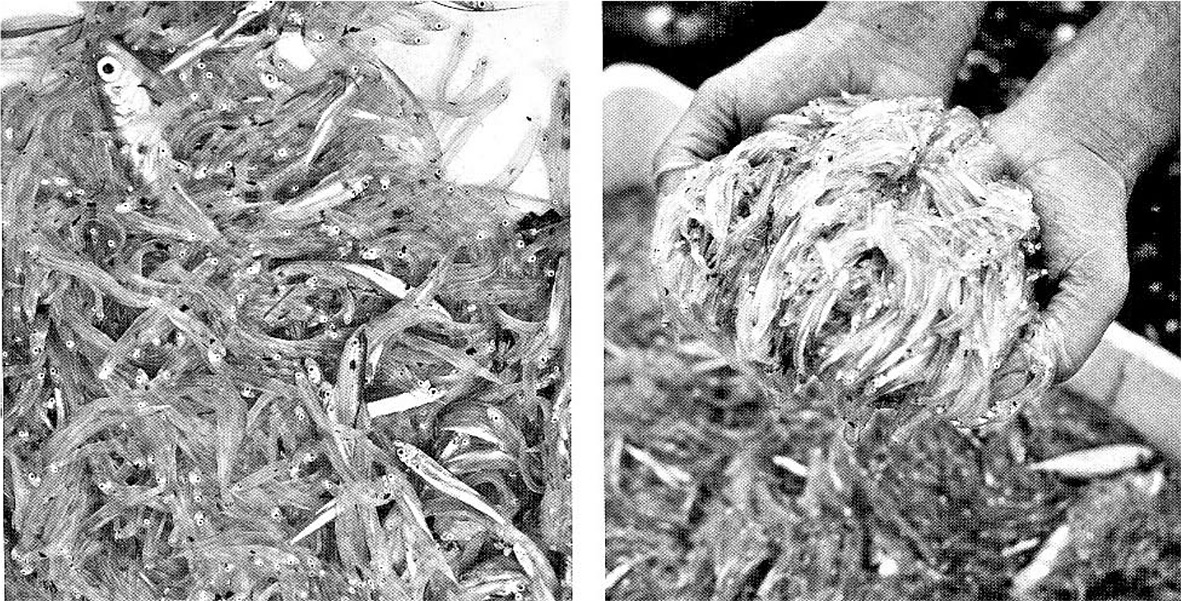
FIGURE 1 Sardine used to make pissalat which are aptly described as «born of rain» by Pliny (HN 61.95; Delaval & Poignant, 2007: 62).
Sud Perduto II. Dressel 7/9, 1st Century AD, Scomber japonicus 40-48 cm (Parker, 1992: 1121; Desse- Berset, 1993: 343, Desse-Berset & Desse, 2000: 76-79)
Cape Bear III (Port Vendres) Dressel 12, Scomber japonicus 28-40 cm (Parker, 1992: 171; Desse-Berset & Desse, 2000: 80)
Port Vendres II Dressel 7, Scomber japonicus size unknown (Colls et al., 1977: 40-43; Parker, 1992: 331; García Vargas, 1998; Desse-Berset & Desse, 2000: 81)
St Gervaise III, Beltran 2b, Trachurus trachurus 40-50 cm (Parker, 1992: 373; Desse-Berset & Desse, 2000: 81)
Anse Gerbal (Port Vendres 1) c.325 AD, Almagro 50/51 Sardina pilchardus 22-25 cm (Parker, 1992: 874; Desse-Berset & Desse, 2000: 92)
Elba II (Chiessi), mid 1st century AD, Scomber japonicus 30 cm (Bruschi & Wilkins, 1996: 167; Dellusi & Wilkins, 2000)
Grado , 2nd century AD, Scomber japonicus 30 cm and Sardina pilchardus size unknown (Auriemma, 2000: 31-49; Dellusi & Wilkins, 2000: 53-65).
Cala Reale al Asinara, 4/5th century AD, Almagro 51, Sardina pilchardus size unknown (Dellusi & Wilkins, 2000; Desse-Berset & Desse, 2000).
TABLE 2 Ship wreck evidence currently considered salted fish.
Only one Roman shipwreck has been tentatively identified as carrying a fish sauce allec and that is Randello (see Table 1; Wheeler & Locker, 1984). This is due to the large number of fishes represented relative to the size of the amphora, and their very small size. There are two key shipwreck sites that require discussion. Grado, a 2nd century AD wreck in the northern Adriatic is exceptional in having large quantities of well-preserved mackerel and sardine bones in numerous different types of large African amphorae as well as small but empty amphorae with a tituli picti stating the product as a liq(uamen) Flos. The bones are currently identified as a salted fish (Auriemma, 2000: 31-49; Dellusu & Wilkens, 2000: 53-65). The 1st century AD wreck at Cape Bear III at Port Vendres contained Dressel 12 amphorae, and the mackerel apparently transported in them were up to 40 cm in length. I do not think it is possible for mackerel this large to be put inside such an amphora even in pieces: it would have been impossible to get them in or get them out as can be seen from their shape (Desse-Berset & Desse, 2000: 79-81).
The Dressel 12 amphorae (Figure 2) are clearly a liquid container and it is my contention that these shipwrecks as well as many others transporting mackerel (or uniform Clupeidae and Sparidae of a similar nature) were actually carrying a form of mackerel allec.
I was unsure for what economic purpose this served until my experiments demonstrated the logic behind this practice.
http://archaeologydataservice.ac.uk/archives/ view/amphora_ahrb_2005/drawings.cfm?id=67&CFID=2827207&CFTOKEN=41216567.
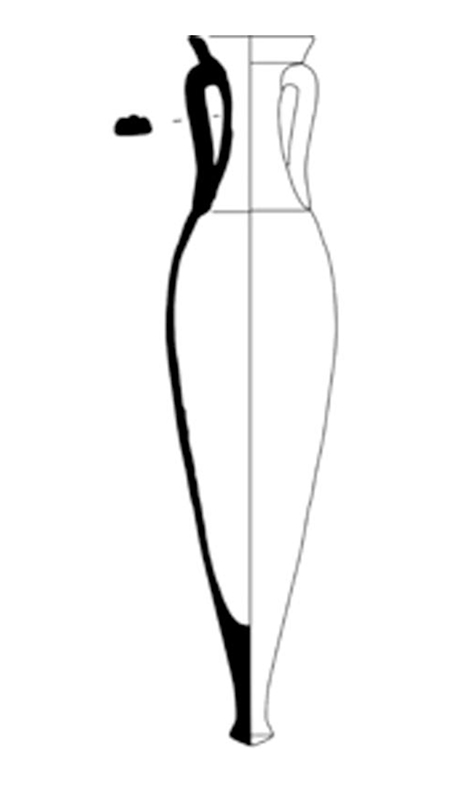
FIGURE 2 Dressel 12 amphora.
THE EXPERIMENTS
Over the last three years, I made 10 different sauces, sticking closely to the basic recipes but adjusting the variables each time in order to determine the perfect conditions required to maximise speed of liquefaction as well as nutritional and culinary quality in the bulk process indicated by the large cetaria (salting tanks) found in Southern Spain and North Africa. I processed my fish in a green house in fish tanks which allowed me to duplicate Mediterranean temperatures quite closely. Most of the data I used to determine these ideal conditions were based on an early observational study which was both complex and time-consuming to relate in detail here. The variables were as follows:
SALT LEVELS: These are stated to be 15% or 7 parts fish to 1 part salt in the Geoponica. The Gargilius recipe is estimated at 3:1 which is much closer to modern fish sauce salt levels and has also been demonstrated to reduce nutritional yield (Klomklao et al., 2006: 443).
PRESENCE OR ABSENCE OF ADDITIONAL VISCERA: In one recipe, smaller fish were pickled with extra viscera, while the other two made no mention of additional viscera. As a bulk catch of Clupeidae and Sparidae could not sensibly be individually processed, this may suggest that the extra viscera was designed to aid the liquefaction process where the viscera cavity was not exposed.
PRESENCE OR ABSENCE OF ADDITIONAL LIQUID: One Geoponica recipe calls for wine at a ratio of 1 fish to 2 wine. This was assumed to be a later stage in production, i.e. the oenogarum sauces mentioned in recipes (Grainger, 2007: 106) and also excessive. The other two recipes, however, made no mention of extra liquid.
FISH VARIETY AND SIZE: I used sprat (5-10 cm) caught and frozen on board ship, sardine (8-24 cm) caught the night before in Scottish waters and mackerel (25-35 cm) caught and salted by myself in the Solent near Portsmouth.
TEMPERATURE: The air temperature of the coastal regions around Cádiz and Gibraltar during the summer range from 15-35°C with an average midday temperature in June, July and August of 30°C. These temperatures were mirrored inside the green house over the duration of the experiments. The liquid temperature of the sauce during the hottest period of the day never reached above 20°C.
CLOSED OR OPEN VESSEL: If the vessel or salting tank was open to the sun, as suggested in the Geoponica, then evaporation will eventually result in a gradual reduction in volume. Either the
sauce was taken before this can happen or extra liquid was added.
OPEN OR CLOSED ABDOMINAL CAVITY: Small fish were left whole. From the Gargilius recipe, it appears that larger fish were cut into pieces, thus exposing the viscera. The Geoponica does not stipulate cutting but implies pieces by the instruction to kneed the fish with salt.
COOKING OR NOT: One of the suggested ways to make fish sauce was to boil the fish in brine and strain the liquor. The text made it clear that this was certainly a separate domestic and small-scale process and that fermentation and cooking were not combined in the bulk process. Modern fish sauce production considers that excessive heat destroys the enzymes that hydrolyse the protein (Geoponica 20.46; Klomklao et al., 2006: 444).
LENGTH OF PROCESSING TIME: The recipes in the Geoponica suggested 2-3 months for the whole fish sauce and 2 months for the blood and viscera sauce. A further Geoponica recipe did not stipulate a time limit, and the Gargilius Martialis recipe appeared to suggest just a few weeks.
SUMMARY OF RESULTS AFTER 3-YEAR OBSERVATION
The exposed and/or extra viscera initially maximized the brine yield. Without one or the other of these and ideally both, the yield of natural water from the fish was too small in volume to dissolve the salt, resulting in a crunchy fish mash. Similar findings were reported by Commis & Re (2009).
As I conjectured, the brine that was generated steadily evaporated, and the sauce yield was limited in the thick gray paste that formed. I lost up to 15% of volume over the first 2 weeks in the first sardine and sprat sauces. I found that when sufficient digesting enzyme activity was present (exposed and/or additional viscera), the skin begun to disappear in the liquid and the muscle tissue appeared to «explode in slow motion» within a few days, i.e. the tissue softened and separated into small particles which floated free within the liquid. This was what formed the dense paste. These particles could rapidly saturate the limited liquid that was present, and, when this happened no further disintegration could take place. It was the smallest fish that dissolved first, while the majority of larger sardine and mackerel pieces remained undissolved, most likely due to the lack of sufficient liquid for the process to take place. The ratio of extra liquid suggested in the Geoponica, (wine but brine was more likely) was 1 fish: 2 liquid. This seemed likely to dilute the sauce too much, and so early experiments used a reversal of this ratio, i.e. 2 fish: 1 brine in sauces with and without additional viscera. The process of disintegration restarted in this new liquid and the thick grey paste became an emulsion. Initially, the dark clear sauce emerged on the top of the tank, while the particles sank and merged with the remaining fish pieces. But as the process of stirring continued, this was reversed, and the particles rose to the surface causing the desirable sauce to be trapped underneath. It is con- jectured that the liquid had become enriched in protein as the density was increased, forcing the particles to float over the heavier liquid. At this point evaporation ceased.
The sauce made from sardines (8-24 cm), without the additional viscera but with 2 fish: 1 extra brine, generated a copious emulsion after three months of processing. At least 40% of the sardine in the 15-24 cm size range, however, remained structurally intact though the viscera cavity was eroded as can be seen in Figure 3.
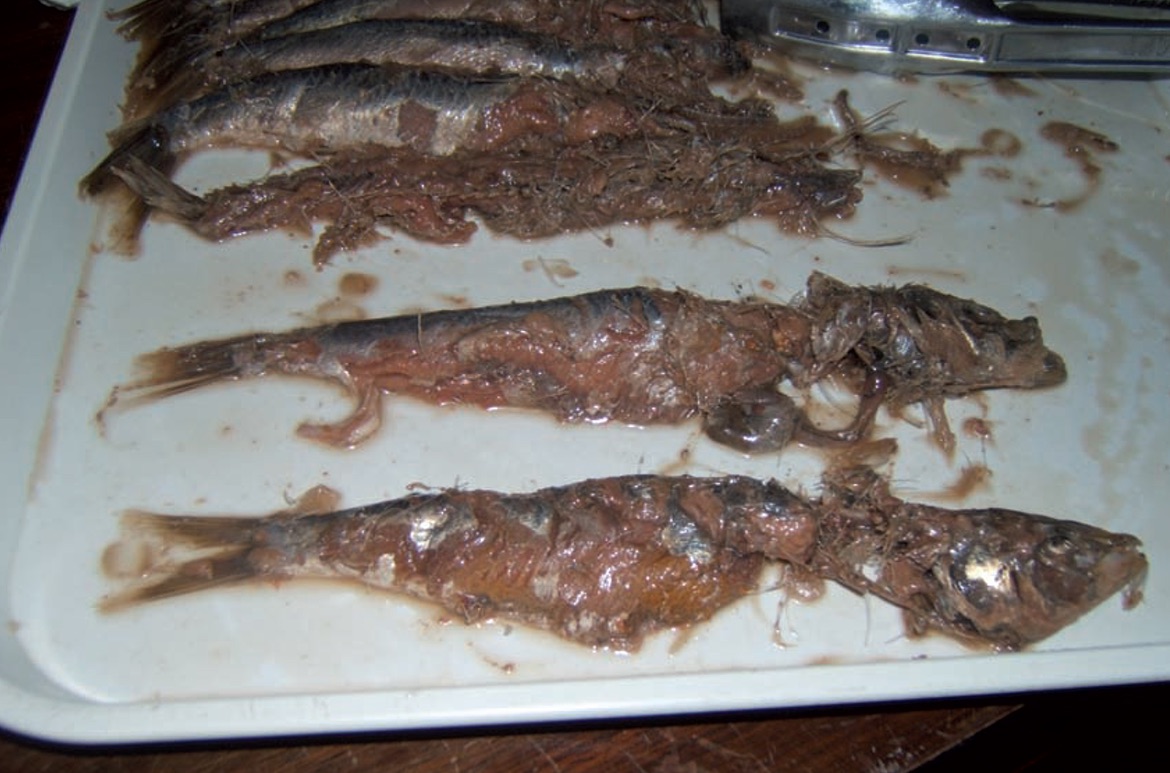
FIGURE 3
Sardines over 15 cm after 3 months of fermentation with their cavity eroded but the majority of muscle tissue intact. This sauce had sufficient liquid but did not contain extra viscera and therefore did not have enough enzyme activity to dissolve the larger fish.
It was possible to re-brine this volume of remaining fish flesh and generate a second sauce which was by no means of second quality. In order to determine whether extra viscerae or more brine or both were necessary to ensure more of the fish were dissolved, an experiment was developed using a batch of mackerel sauce made with the fish cut into 3 pieces and with additional viscera at 10% and the original ratio of brine at 1 part fish to 2 parts brine.
This recipe resulted in a dramatic liquefaction. It took from one week to ten days to liquefy and disarticulate up to 8 kg of mackerel. This was clearly too fast, and, as it was accompanied by fairly rapid spoilage of the sauce in the following months, it was determined that this ratio of extra liquid resulted in a weak and unstable sauce. It also seemed likely that the manufacturer would not want to dilute the sauce in the early stages any more than necessary, particularly as a concentrated fish sauce would be more economical to transport. Further experiments using more viscera and a liquid ratio of 2:1 continued to leave 25-30% of the fish flesh un-liquefied. See Figure 4 for the bony allec from this mackerel sauce.
It seemed likely that the enzymes could not liquefy any more fish in these conditions. A ratio of 2 parts fish to 1 part brine with 10% extra viscera proved the most effective in producing a sauce efficiently liquefied with maximum nutrition while leaving sufficient remaining fish to generate a good second sauce. One may imagine that it would be highly profitable for fish sauce manufacturers to generate two equal sauces in terms of nutrition and taste from one batch of fish.
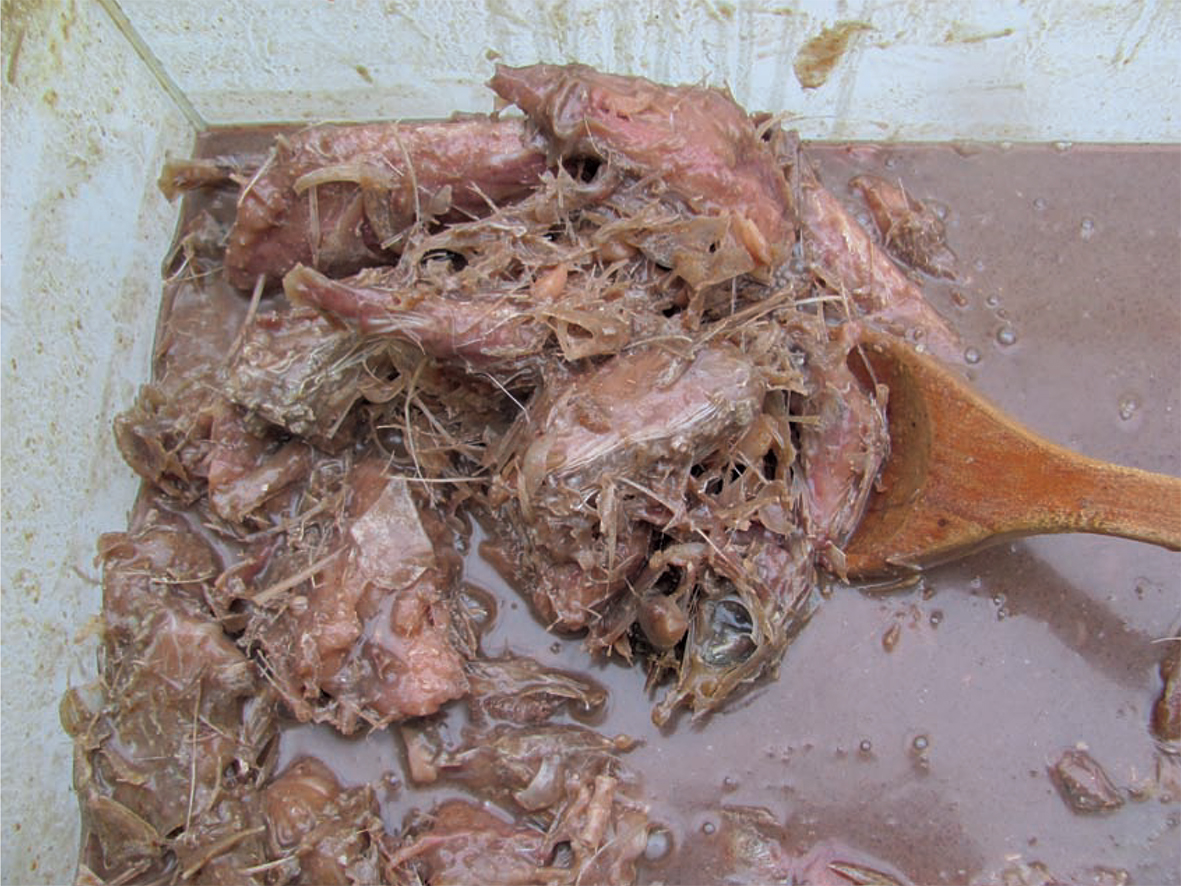
FIGURE 4
A residue (allec) of unliquefied mackerel, having been cut into pieces and processed with sufficient extra viscera and extra liquid to generate a saturated emulsion after 2 months fermentation.
THE SAUCE ITSELF AND ITS NATURE
In ideal conditions of high enzyme activity (provided by the extra viscera, sufficient liquid, and heat), the cartilage is also digested by the enzyme action, and this results in complete disar- ticulation of the smaller fish skeletons (5-10 cm). In these ideal conditions, many of the larger pieces or whole fish still did not fully liquefy in the increased volume of fluid. All the fish pieces and disarticulated bone initially remain suspended if small and then fell to the bottom throughout the majority of the process. With an extended processing time (over 2 months), however, the sauce became so rich in protein that the density of the sauce increased. The bones and even large pieces of undissolved fish rose through the thick layer of fish particles to the surface. Prior to this while the bones were still largely at the bottom, the tank was full of a thick emulsion which could be easily removed with minimal bone contamination. This emulsion constituted the unfiltered sauce. I have been able to demonstrate through laboratory test- ing that the nutritional value of the final sauce was greatly improved by storage in this unfiltered state. After discussing this product with Robert Curtis, he agreed that this unfiltered sauce could well be identified with the tituli picti «flos». When these identifying labels signify flos flos or floris, it is possible that a filtered sauce, i.e a sauce derived from the flos («flower of the flower»), was intended, though we can also see from tituli picti that other ways to signify a filtered sauce were possi- ble [CIL 4.7110: liquamen optimum saccatum «the best filtered fish sauce»; Curtis (1991: 195), Grainger (2010: 69)]. Had this product been put directly into an amphora, it would continue to set- tle out with the desirable sauce in the base spike while the paste forms a plug near the top. Figure 5 shows a mackerel flos liquamen after it has settled.
Currently, I am experimenting with the possibility that this emulsion was diluted at this stage (with reference to common tituli picti for lymphatum) to reduce the specific gravity and cause the bone-free allec to settle into the spike and free up the sauce so it can be accessed. This would then constitute the bone-free allec valued as a fish paste.
WHAT HAPPENED TO THE BONES
When larger fish such as mackerel (20-40 cm) are used, I estimate that as much as 40% of the fish can remain undissolved and clearly constitute a potential second sauce. When smaller and very small fish (5-10 cm) are used such as Sprattus sprattus, the majority of the flesh is dissolved and the bones disarticulate, but the layer of bone is thick and rich in allec and able to generate a second sauce of lesser quality if diluted. In both scenarios, re-brining could occur either in situ or, as I would like to suggest, once the allec has been put into other amphorae. This would free up the processing tank for another batch of fish while they are in abundance during the summer months and allow the second sauces to be generated in transit.
The small-scale recipes recommended using a basket to filter the sauce of bone when it was removed. On a large scale, this seems both unwieldy and hard to envision. Without a bone filter, as the emulsion was removed, more of the thick sauce will be contaminated by the bone. In fact, it is likely the process of removal of the sauce did not stop, i.e. as the bone was revealed, it sim- ply went into other amphorae. In this way, early amphorae used for the flos product would have small amounts of bone, while later ones, probably of a different shape, contained larger amounts. In each case, it was the liquid fish sauce that was the final product. The bones were transported because they still retained flesh or were in a thick paste and could not be easily removed if disarticulated. We have been looking for a rational economic reason why what appears to be a very bony fish sauce residue was shipped so widely. We believe we now have a logical reason. Rather than the bony allec being a fish paste of limited value, it was simply a semi-processed fish sauce waiting further processing. In transit, the sauce developed its protein levels, and, at the port, market, or place of use, the new flos emulsion would be poured off the bones remaining in the amphora. It is very likely that many of the urban sites with evidence of allec will undoubtedly represent this discarded bone (see Table 2).
One of the defining characters of the fish sauces» residues found on land, first identified by Desse-Berset & Desse (2000: 91), was the quality of the preservation. The bones were often fragmentary, even described as fish bone flour. This damage was judged to be caused by the fermentation process and decomposition. Also, it was assumed that, as cooking is considered to be part of the process, this would have also damaged the bone (Desse-Berset & Desse, 2000: 93). It is important to note that there was no apparent dam- age to the bones caused by the fermentation process (Figure 6 shows mackerel opercula after a successful fermentation).
There was also no evidence of digestion in the form of acid etching. As already noted, cooking of a fish sauce appeared to be a separate and domestic process that was unlikely to have been used in conjunction with fermentation, and modern fish sauce techniques confirm this (Klomklao et al., 2006: 444). It is therefore possible to demonstrate that a shipment of mackerel allec subsequently ship-wrecked in the Mediterranean only a few weeks after processing would contain substantial amounts of flesh on articulated skeletons. In these circumstances, it would be impossible to distinguish between a salted fish product and one intended to be a fish sauce, using the current criteria identified by Desse-Berset & Desse (2000: 93). It seems like- ly that the defining factor in a case like Cape bear III would be the shape and size of the amphorae. In this case, the Dressel 12 amphorae, with their narrow elongated body and narrow neck, would clearly suggest semi-liquid rather than solid pieces. The Grado wreck is also of great significance. Many of the sardines remained articulated, and organic matter was present which suggest the ship may have gone down very shortly after departing. We can now see that the empty amphorae labelled as liquamen flos may have held the first sauce while the fish bones, placed in whatever amphorae were available, represented the second sauce being generated in transit.
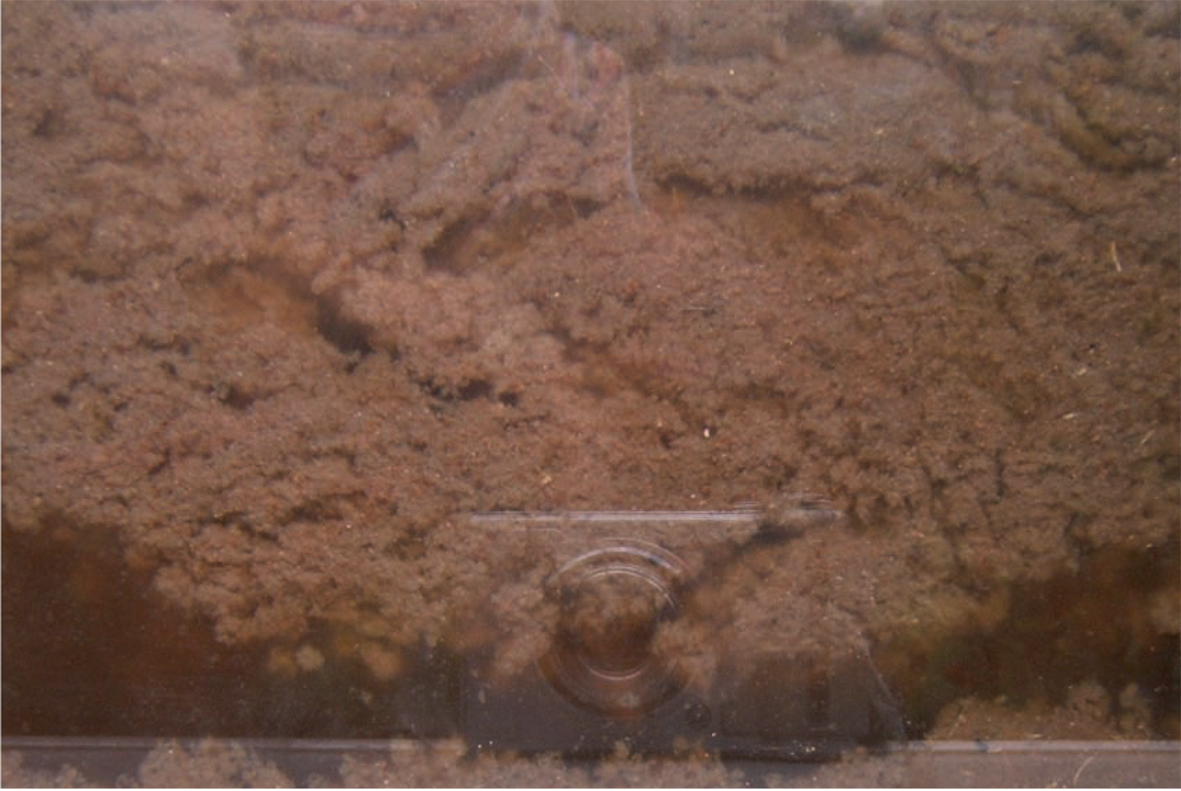
FIGURE 5
The sauce in the form of an emulsion removed from fermented sardine, demonstrating the particles of muscle tissue in the liquid. We may considered this a «flos liquamen».
FIGURE 6
Mackerel opercula from an efficient mackerel liquamen demonstrating little damage or acid erosion.
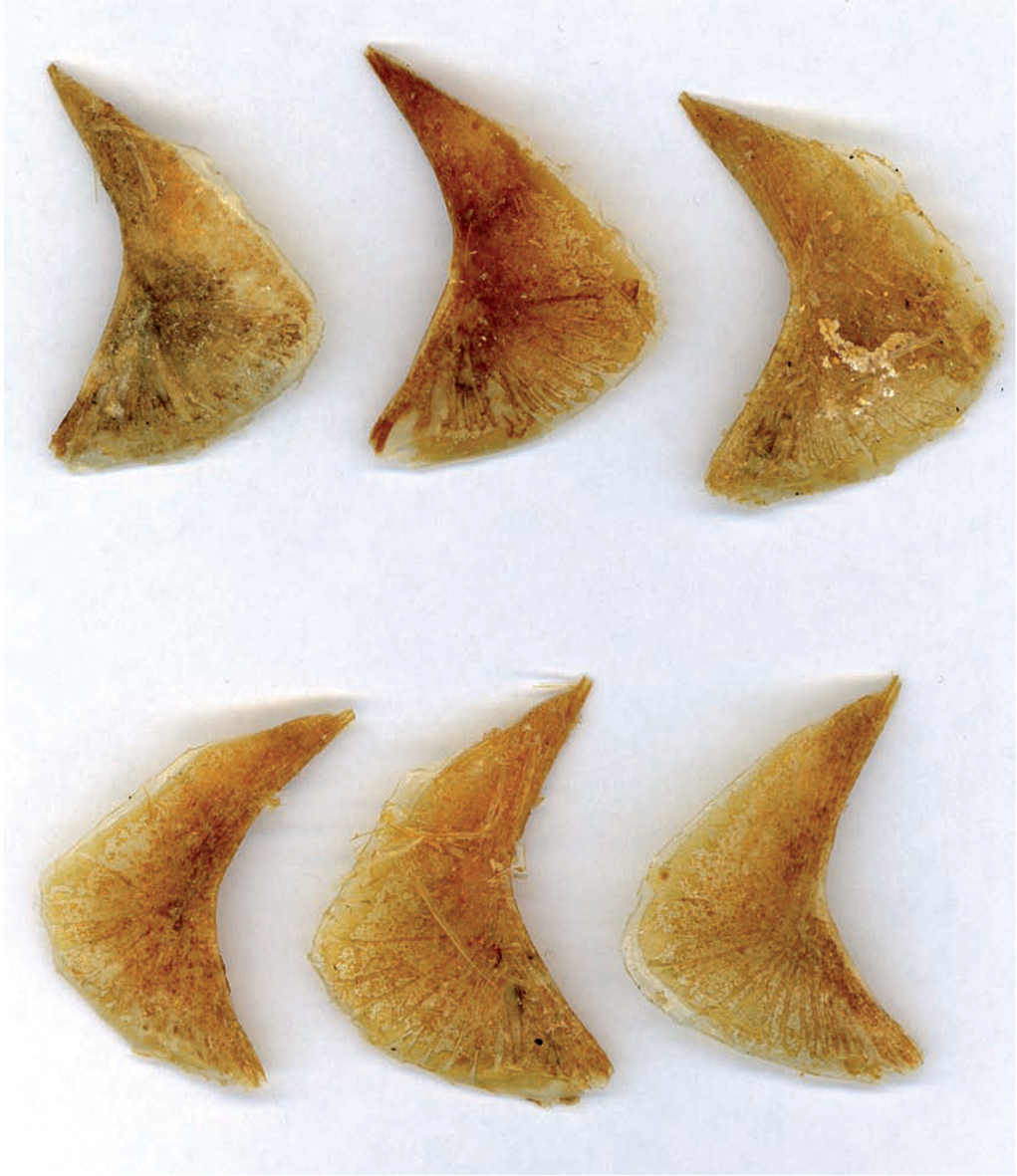
CONCLUSIONS
It has been possible to demonstrate that the residue of ancient fish sauce known as allec probably existed in two forms: the bone, and semi-digested fish mash which constituted a fish sauce concentrate being generated in transit and a runny bone free fish paste. The latter was likely found in the spike of fish sauce amphorae and was probably consumed as a relish or even re-brined to generate the genuine second-quality sauces that we find on amphora tituli picti. I believe it can also be demonstrated that, when whole fish sauce was manufactured, a «second sauce» from the same batch of fish may also have been shipped alongside the first sauce, and this constituted the allec currently identified as a separate bony fish paste. Both products may have needed further processing by traders and merchants before being ready for sale. The fish bone evidence associated with shipwrecks and discarded amphorae from urban sites needs re-evaluating in light of these findings. It may be possible, when finding in the future new shipwrecks, to compare the shape of amphorae with the fish bone evidence inside the vessels and determine just what was being shipped. Many of the fish bones currently considered a salted fish product were shipped in the Dressel 7-14 forms which amphorae specialists consider a fish sauce vessel rather than a salted fish vessel. One may imagine that liquids and solids would ideally be shipped in vessels designed for this purpose as Opait (2007: 117) has pointed out. The choice of vessel would clearly depend on circumstances and availability, and the re-use of amphorae make the whole issue very much more complex. The fact of re-use may render any firm conclusions about the products inside impossible. These preliminary conclusions have opened up the issue of the trade in fish across the Mediterranean. In turn, they may have profound consequences not only for our interpretation of the fish bone evidence associated with fish sauce but also much wider implications for our interpretation of the ancient economy and more particularly the relationship between Spain and Italy in terms of the trade in fish and other products.
APPENDIX 1
The Geoponica 46. Making gara
The so-called liquamen is made thus. Fish entrails are put in a container and salted; and little fish, especially sand-smelt or small red mullet or mendole or anchovy, or any small enough, are all similarly salted; and left to pickle in the sun, stirring frequently. When the heat has pickled them, the garos is got from them thus: a deep close woven basket is inserted into the centre of the vessel containing these fish, and the garos flows into the basket. This, then, is how the liquamen is obtained by filtering through the basket; the residue makes alix.
The Bithynians make it thus. Take preferably small or large mendole, or, if none, anchovy or scad or mackerel, or also alix, and a mixture of all these, and put them into a baker’s bowl of the kind in which dough is kneaded; to one modios of fish knead in 6 Italian pints of salt so that it is well mixed with the fish, and leaving it overnight put it in an earthenware vessel and leave it uncovered in the sun for 2 or 3 months, occasionally stirring with a stick, then take [the fluid?], cover and store. Some add 2 pints of old wine to each pint of fish.
If you want to use the garon at once, that is, not by ageing in the sun but by cooking, make it thus. Into pure brine, which you have tested by floating an egg in it (if it sinks, the brine is not salty enough) in a new bowl, put the fish; add oregano; place over a sufficient fire, until it boils, that is, until it begins to reduce a little. Some also add grape syrup. Then cool and filter it; filter a second and a third time until it runs clear; cover and store. A rather high quality garos, called haimation, is made thus. Take tunny entrails with the gills, fluid and blood, sprinkle with sufficient salt, leave in a vessel for two months at the most; then pierce the jar, and the garos called haimation flows out.
Translation: Andrew Dalby (2011), The Geoponica Prospect Books.
(Pseudo) Gargilius Martialis, Medicinae ex holeribus et pomis 62.
A confection of liquamen which is called oenogarum.
Naturally oily fishes are caught/ taken, such as are salmon and eels and shad and sardines or herrings, and an arrangement of the following kind is made of them along with dried fragrant herbs with salt/ they are put together with fragrant died herbs and salt in this way. A good, sturdy vessel. well pitched, with a capacity of three or four modii, is got ready, and dried herbs with a good fragrance are taken – these can be garden or field herbs – namely dill, coriander, fennel, celery, sicareia, sclareia?, rue, mint, sisymbrium (?wild thyme), lovage, pennyroyal, oregano, bettony, argemonia, and the first layer is spread out at the bottom of the vessel using these. Then the second layer is laid down using fish –whole if they are small, cut in pieces if they are larger – over this is added the third layer of salt two fingers deep, and the vessel is to be filled right to the top in this, with succes- sive triple layers of herbs, fish and salt. It should then be closed up with a lid fitted and put aside as it is for seven days.
When the seven days are over, the mixture should be stirred right to the bottom, using a wooden paddle shaped like an oar, twice or three times every day. When this process is complete, the liquor which flows out of this mixture is collected. And in this way liquamen or oenogarum is made from it. Two sextarii of this liquor are taken and are mixed with half a sextarius of wine, then single bundles of (each of) four herbs – viz. dill, coriander, savoury and sclareia. A (one) little handful of fenugreek seed is also thrown in, and of the aromatics thirty or forty grains of pepper, three pennies of costum by weight, the same of cinnamon, the same of clove, and when pounded up finely these are mixed with the same liquor.
Then this mixture should be cooked in an iron or a bronze pan until it reduced to a sextarius in volume. But before it is cooked half a pound of purified honey ought to be added to it. When it has been cooked it ought to be strained through a bag like a medicine until it is clear – it needs to be boiling when it is poured into the bag. When clarified and cooled it is kept in a well-pitched vessel in order to give flavour to opsonia.
Translation Dr C. Grocock


